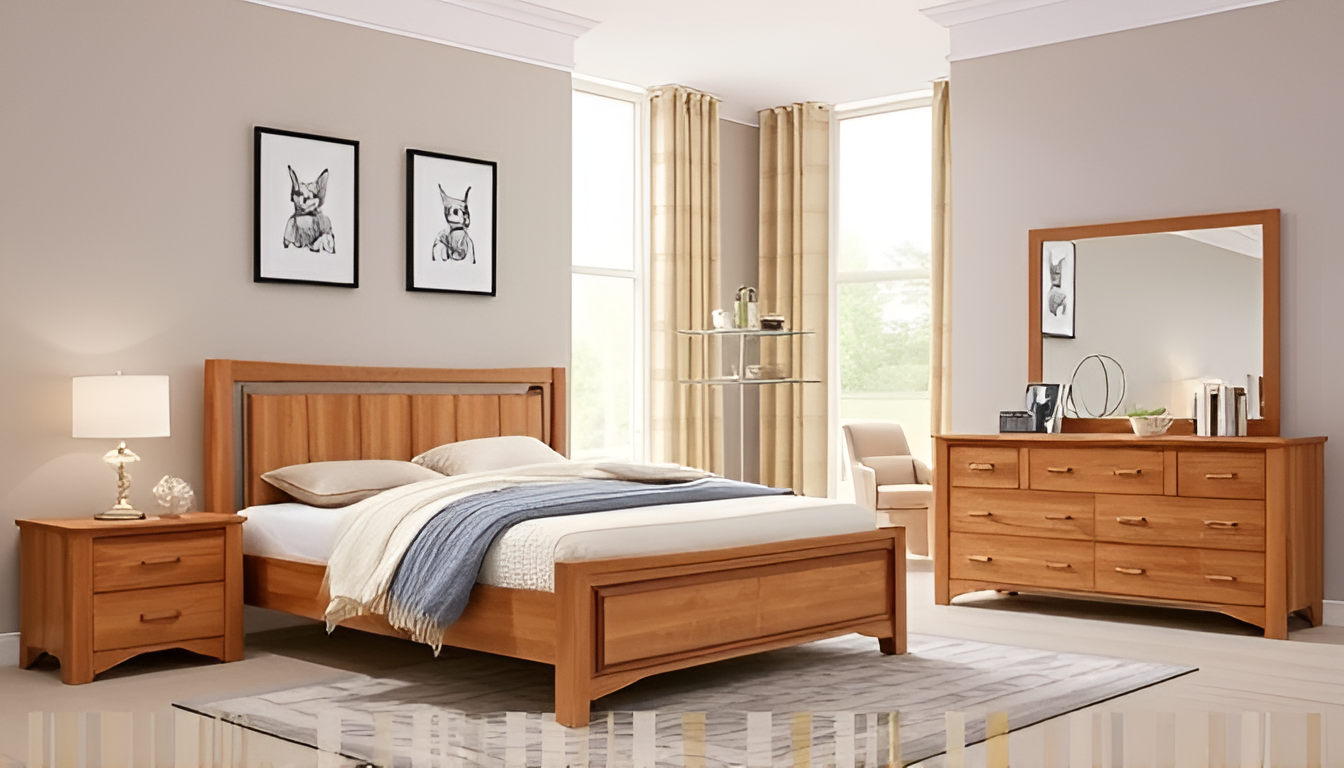How to Maintain Wooden Bedroom Furniture in Dubai

Wooden bedroom furniture brings warmth, elegance, and timeless beauty to any space. In Dubai, where humidity and temperature fluctuations can affect the durability of wood, maintaining such furniture is essential to preserving its value and appearance. Whether it’s a luxurious mahogany bed frame, a sleek oak dresser, or a rustic pine wardrobe, proper care is crucial. This comprehensive guide provides practical steps and expert advice on how to keep your wooden bedroom furniture in pristine condition for years to come.
1. Understanding Dubai’s Climate and Its Impact on Wood
The climate in Dubai presents unique challenges for wooden furniture. With temperatures soaring beyond 40°C in summer and occasional high humidity levels, wood can react by expanding, contracting, or warping. Here’s how Dubai’s environmental conditions may impact your wooden bedroom furniture:
- Heat and dryness can cause cracks, shrinkage, or the splitting of wooden surfaces.
- Humidity can lead to swelling, warping, or mildew growth, especially if wood is left untreated.
- Air conditioning in homes, although crucial for comfort, can further dry the wood, accelerating deterioration over time.
A good maintenance routine, therefore, involves creating the right environment for your furniture while using specific care practices to address climate-related issues.
2. Keep the Furniture Away from Direct Sunlight
In Dubai, intense sunlight streaming through windows can cause wood to fade or discolor over time. Continuous exposure to UV rays also weakens the structural integrity of the furniture.
Solutions:
- Use curtains or blinds: Install thick curtains or blackout blinds to block sunlight, especially in rooms with east or west-facing windows.
- Position furniture strategically: Keep bed, dressers, and wardrobes away from direct sunlight. If moving the furniture isn’t possible, consider covering surfaces with decorative fabric.
- Apply UV-protective coatings: Some wood finishes contain UV blockers that help minimize sun damage.
3. Regular Dusting and Cleaning Techniques
Dust buildup can dull the finish and cause microscopic scratches on wooden surfaces. Dubai’s occasional dust storms and frequent construction activities can worsen this problem, making regular dusting essential.
Tips for Effective Cleaning:
- Use a soft, lint-free cloth like microfiber to gently wipe dust off surfaces.
- Avoid feather dusters, as they may scratch the wood.
- For deeper cleaning, dampen the cloth slightly with water or a mild wood-safe cleaner. Ensure the cloth is wrung out well to prevent moisture from penetrating the wood.
- Wipe along the grain of the wood for better results and to avoid streaks.
4. Control Humidity Levels Indoors
Wood is highly sensitive to moisture. High humidity levels can cause swelling, while excessively dry air leads to shrinkage. This is particularly relevant for bedroom furniture in Dubai, where homes rely heavily on air conditioning, creating a dry indoor environment.
Maintaining Ideal Humidity:
- Use a humidifier during dry seasons to maintain balanced moisture levels.
- In humid months, employ a dehumidifier to prevent excess moisture from settling on your furniture.
- Consider placing silica gel sachets inside wardrobes and drawers to absorb humidity and prevent mold growth.
5. Apply Protective Finishes and Polishes
Wood furniture benefits from occasional polishing, which helps restore its natural luster and provides a protective layer against moisture and dust. However, choosing the right polish or finish is essential to ensure it complements the wood type and withstands Dubai’s climate.
How to Choose and Apply Polish:
- Use natural oils like linseed oil or beeswax to nourish untreated or unfinished wood.
- For varnished or lacquered furniture, use furniture wax or polish designed for sealed surfaces.
- Apply polish with a soft cloth, working in circular motions for even coverage.
- Avoid over-polishing, as excessive product can build up and attract dust.
6. Handling Scratches, Dents, and Stains
Minor damages such as scratches, dents, and stains are inevitable, especially on furniture that sees frequent use. With the right approach, these blemishes can be minimized or removed entirely.
Simple Fixes for Common Issues:
- Scratches: Rub walnut or almond meat along shallow scratches to mask them. For deeper scratches, use wood repair markers or touch-up pens.
- Dents: Place a damp cloth over the dent and gently apply heat with an iron. The moisture and heat help the wood fibers expand and return to their original shape.
- Stains: Wipe spills immediately with a dry cloth to prevent staining. For persistent stains, use a wood cleaner or a mix of vinegar and olive oil to remove them without damaging the finish.
7. Protect Furniture from Everyday Wear and Tear
Wooden bedroom furniture often endures heavy use, such as nightstands holding hot beverages or wardrobes facing daily handling. Implementing small protective measures can go a long way in maintaining your furniture's longevity.
Preventive Measures:
- Use coasters and placemats to avoid heat rings on wooden surfaces.
- Place felt pads under the legs of furniture to prevent scratches when moving them.
- Line drawers and shelves with fabric or drawer liners to protect against scuffs and stains.
- Encourage family members to handle furniture gently, especially when opening and closing drawers or wardrobe doors.
8. Schedule Seasonal Inspections and Repairs
Routine inspections allow you to identify early signs of damage, such as cracks, loose joints, or mold growth, ensuring that minor issues don’t escalate. Regular repairs also extend the life of your furniture.





